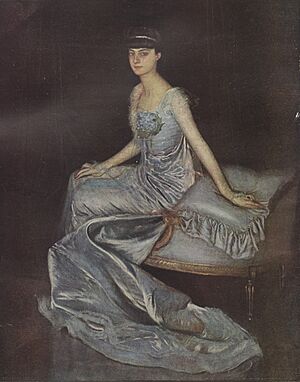Antonio de La Gándara facts for kids
Quick facts for kids
Antonio de La Gandara
|
|
|---|---|

Antonio de La Gandara, self portrait, 1888
|
|
| Born |
Antonio de La Gandara
16 December 1861 |
| Died | June 30, 1917 (aged 55) |
| Resting place | Le Cimetière Père Lachaise, Paris, France (Père Lachaise Cemetery) |
| Nationality | French |
| Education | Jean-Léon Gérôme, Alexandre Cabanel |
| Known for | Drawing, painting, lithographs, illustrations |
|
Notable work
|
Portrait de la Comtesse de Noailles; Portrait d'Ida Rubinstein; Portrait de Romaine Brooks; Portrait de Charlotte de La Gandara; Portrait de la comtesse de Montebello (1892); Portrait de Robert De Montesquiou |
| Movement | Belle Époque |
| Awards | Mention honorable, Salon des artistes français, 1884; Bronze medal, Exposition Universelle, 1889; Silver medal, Exposition Universelle, 1900; Chevalier de la Legion d'honneur, 1900 |
Antonio de La Gándara (born December 16, 1861 – died June 30, 1917) was a talented French artist. He was known for his paintings, pastel drawings, and sketches during a beautiful time in Paris called the Belle Époque.
Contents
Who was Antonio de La Gándara?
Early Life and Artistic Training
Antonio de La Gándara was born in Paris, France. His father was from Spain, and his mother was from England. This mix of cultures greatly influenced his artistic talent.
When he was just 15 years old, Antonio was accepted into the famous École des Beaux-Arts (School of Fine Arts). There, he studied with well-known artists like Jean-Léon Gérôme and Cabanel.
Antonio quickly gained recognition. In 1883, the judges at the Salon des Champs-Élysées praised his very first artwork. This was a portrait of Saint Sebastian.
Becoming a Popular Artist in Paris
In less than ten years, Antonio de La Gándara became a favorite artist among the wealthy and important people of Paris. He painted portraits of many famous individuals. These included Countess Greffulhe, the Grand Duchess of Mecklenburg, and Sarah Bernhardt, a famous actress.
One of his well-known subjects was Virginie Amélie Avegno Gautreau. She was also painted by John Singer Sargent in his famous work, Madame X.
Antonio was influenced by artists like Jean-Baptiste-Siméon Chardin. He was skilled at showing simple beauty with amazing detail in his portraits. He also captured the calm feeling of Paris scenes, like its bridges, parks, and streets.
Illustrations and Exhibitions
Antonio de La Gándara also illustrated a few books. One of these was Les Danaïdes by Camille Mauclair. He also worked with other artists, including James McNeill Whistler, on a book called Les Chauves-Souris (which means "The Bats"). This book was written by the French poet Robert de Montesquiou and published in 1893. Today, it's a rare item for collectors.
In 1898, Antonio's first art show in New York was a huge success. This show, organized by Paul Durand-Ruel, confirmed him as a leading artist of his time. His portraits often appeared on the front pages of popular magazines like Le Figaro. He also showed his art in major exhibitions in cities like Paris, Brussels, Berlin, and Barcelona.
Later Life and Legacy
Antonio de La Gándara passed away on June 30, 1917. He was buried in the Père Lachaise Cemetery in Paris.
After his death, his fame faded for a while. However, in the 20th century, people became interested in his work again. He is now seen as an important artist who captured the art and spirit of his era. His life and art were even mentioned by famous writers like Marcel Proust.
In 2018, a large exhibition of his work opened at the Musée Lambinet in Versailles. It showed over one hundred of his paintings and many documents. A novel about his life, called Antonio de La Gandara – The Gentleman painter of the Belle Epoque, was also published that year.
Literature
- Gabriel Badea-Päun, Portraits de Société, Paris, Citadelles et Mazenod, 2007.
- Gabriel Badea-Päun, The Society Portrait, Thames & Hudson, London and Vendôme Press, New York, 2007.





